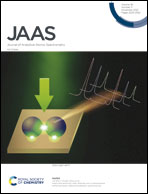Development and performance evaluation of a multi-modal optical spectroscopic sensor†
Abstract
The development of multi-modal optical spectroscopic sensors for sample analysis is often challenging because of the requirement of signal collection and measurement techniques and devices to cover different spectral regions with varying resolutions, spectral ranges and time scales of signal production. In the present study, the evaluation of the performance of a multi-modal laser-spectroscopy system that combines three different spectroscopic techniques (Laser-Induced Breakdown Spectroscopy (LIBS), Raman spectroscopy, and Laser-Induced Fluorescence (LIF)), is discussed, with a combination of single laser and single detector for all these investigations. While LIBS is a widely applied elemental detection technique, Raman and LIF are used for molecular characterization. The multi-spectral information accessible from a single device opens up new avenues for comprehensive material characterization of any sample. Additionally, the utilization of a single laser and single detector makes the system overall compact, cost-effective, and more suitable for field applications. The intensified charge-coupled device (ICCD)-coupled echelle spectrograph with its simultaneous broad spectral range in a given setting, high resolution, and potential to perform time-gated spectroscopy is eminently suitable for such multi-modal applications. The present work describes the results of optimization of this system for multi-modal optical spectroscopy using standard, readily available samples (rhodamine-6G, etc.) and performance assessment of the same has been carried out on realistic samples.



 Please wait while we load your content...
Please wait while we load your content...